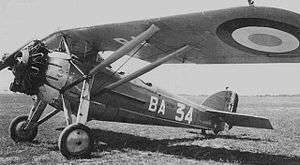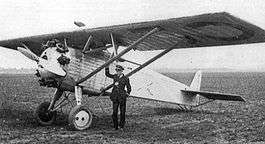Wibault 7
| Wibault 7 | |
|---|---|
 | |
| Wibault 74 | |
| Role | Monoplane fighter |
| National origin | France |
| Manufacturer | Wibault |
| First flight | 1924 |
| Introduction | 1929 |
| Primary user | Aéronautique Militaire |
| Variants | Vickers Wibault |

The Wibault 7 was a 1920s French monoplane fighter designed and built by Société des Avions Michel Wibault. Variants were operated by the French and Polish military and built under licence for Chile as the Vickers Wibault.
Development
Developed from the earlier Wib.3 the Wibault 7 was a C.I category single-seat high-wing braced parasol monoplane fighter powered by a 480 hp (360 kW) Gnome-Rhone 9Ad radial engine. The main difference from earlier aircraft was the use of an all-metal construction system which was patented by Wibault. The first prototype flew in 1924, and was followed by two more prototypes. Despite being placed only third in the competition (behind the Nieuport-Delage NiD 42 and the Gourdou-Leseurre GL.32), an order for 25 Wib.7s was placed in January 1927.[1] These were followed in production by 60 aircraft for the Aéronautique Militaire as the Wib.72 which entered service in 1929. 26 Wib.7s were built for Chile under licence by Vickers in England. Plans to build the aircraft in Poland by the PZL company did not come about, although the company did deliver three aircraft fitted with Wright radial engines and 25 Wibault 72s to the Polish military. The next variant was the Wib.73, with seven built for Paraguay. The French Navy bought some carrier-capable Wib.74s with a strengthened fuselage and arrestor hook.
Variants
- Wib.7
- Prototype powered by a 480 hp (358 kW) Gnome-Rhone 9Ad radial engine. Two further prototypes followed by 25 production aircraft.[1]
- Wib.71
Re-engined with a 400 hp (298 kW) Hispano 12 Jb engine but redesignated Wib.9 before completion.[1]
- Wib.72
- Strengthened production aircraft for French Air Force and Poland. 85 built.[1]
- Wib.73
- Production aircraft for Poland and Paraguay powered by 336 kW (451 hp) Lorraine-Dietrich 12Eb W engine. 11 built .[1]
- Wib.74
- Production navalised aircraft for the French Navy. 18 built.[1]
- Vickers Wibault Scout
- Licensed production with a Bristol Jupiter engine for Chile, 26 built.
Operators
- Paraguayan Air Force received 7 Wib.73s. Three remained in service at the outbreak of the Chaco War between Paraguay and Bolivia.[1]
Specifications (Wib 7)
Data from The Complete Book of Fighters[1]
General characteristics
- Crew: one
- Length: 7.45 m (24 ft 5 1⁄3 in)
- Wingspan: 11.00 m (36 ft 1 1⁄8 in)
- Height: 2.90 m (9 ft 6 1⁄8 in)
- Wing area: 22.0 m2 (236.8 ft2)
- Empty weight: 827 kg (1,823 lb)
- Gross weight: 1,444 kg (3,183 lb)
- Powerplant: 1 × Gnome et Rhône 9Ac, 313 kW (420 hp) each
Performance
- Maximum speed: 227 km/h (141 mph)
- Range: 600 km (373 miles)
- Service ceiling: 8,500[2] m (27,900 ft)
- Rate of climb: 5.4[3] m/s (1,070 ft/min)
Armament
- 2x 7.7 mm Vickers machine guns
See also
- Related development
- Related lists
References
| Wikimedia Commons has media related to Wibault aircraft. |
- Notes
- Bibliography
- Angelucci, Enzo. The Rand McNally Encyclopedia of Military Aircraft, 1914-1980. San Diego, California: The Military Press, 1983. ISBN 0-517-41021-4.
- Green, William and Gordon Swanborough. The Complete Book of Fighters. New York: Smithmark, 1994. ISBN 0-8317-3939-8.
- The Illustrated Encyclopedia of Aircraft (Part Work 1982-1985). London: Orbis Publishing, 1985.
- Taylor, Michael J. H. Jane's Encyclopedia of Aviation. London: Studio Editions, 1989. ISBN 0-517-69186-8.